- About MAA
- Membership
- MAA Publications
- Periodicals
- Blogs
- MAA Book Series
- MAA Press (an imprint of the AMS)
- MAA Notes
- MAA Reviews
- Mathematical Communication
- Information for Libraries
- Author Resources
- Advertise with MAA
- Meetings
- Competitions
- Programs
- Communities
- MAA Sections
- SIGMAA
- MAA Connect
- Students
- MAA Awards
- Awards Booklets
- Writing Awards
- Teaching Awards
- Service Awards
- Research Awards
- Lecture Awards
- Putnam Competition Individual and Team Winners
- D. E. Shaw Group AMC 8 Awards & Certificates
- Maryam Mirzakhani AMC 10 A Awards & Certificates
- Two Sigma AMC 10 B Awards & Certificates
- Jane Street AMC 12 A Awards & Certificates
- Akamai AMC 12 B Awards & Certificates
- High School Teachers
- News
You are here
Martin Gardner's Magic Spells
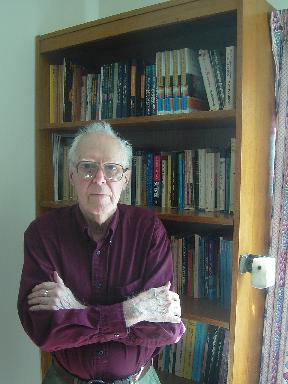 |
|
Martin Gardner stands by every word he ever wrote: the six shelves consist entirely of his own publications, dating back to 1931. |
October 2006
Winning Ways (Academic Press, 1982), by Elwyn R. Berlekamp, John H. Conway & Richard K. Guy, is dedicated to "Martin Gardner, who has brought more mathematics to more millions than anyone else." It's been half a century since Martin Gardner's magic spell was first cast over the general public, thanks to two landmark events in the world of publishing: the appearance of his Mathematics, Magic and Mystery (Dover 1956), the first book for non-magicians to treat mathematical cards tricks in depth, and the launching of his long-running monthly "Mathematical Games" articles in Scientific American. (One could argue that the latter turned out to be, among other things, the original Card Column!)
This month, for our lucky thirteenth Card Colm, we take a break from our usual format and celebrate Martin Gardner's ninety-second birthday by sharing his recent musings on the origins of these classy and influential publications.
Along the way, the conversation turns to the highly eccentric and equally innovative mid-twentieth century magician and mathematical card trick inventor Bob Hummer, and the longevity of Gardner's own writing career, which has seen him publish an average of one book a year, on subjects as diverse as recreational mathematics, physics, pseudoscience, philosophy, religion and Alice in Wonderland, for three-quarters of a century. He also reveals details of some of his current projects—including completely updating the fifteen books spawned by the Scientific American columns.
Remember to keep a deck of cards handy: we wrap up with a recent refinement of an old spelling routine of his.
An Interview with Martin Gardner
CC: It's 2006, so it's fifty years since Mathematics, Magic and Mystery appeared. I wondered if we could wind the clock back a little bit and if you can tell us how that book came about.
MG: When I was living in New York, I use to go to a gathering of mathematicians at Yeshiva University, and it was a gathering that was run by a fellow named Jekuthiel Ginsburg who edited Scripta Mathematica, a magazine devoted to history of mathematics. He found out that I was interested in mathematical magic and asked me to do a series of articles, for Scripta. So I did a series of pieces, one on card tricks and one on dice tricks and on miscellaneous objects and so on, and I put those together and that became a book. That is how it became about and Dover published it and I was paid a total of $500 for it. No royalties, but later it got translated into French and German and fortunately for me and unfortunately for Dover, they forgot to put into the clause anything about foreign sales. So I got all the royalties on foreign sales and made far more on the German edition then I did on the English one. That is how that came about.
CC: It has been in print ever since, hasn't it?
MG: It has been in print ever since, right.
CC: How long did it take to write it then?
MG: Oh, I don't remember. Not so long though.
CC: So the Scripta appearances had appeared over a period of a couple of years?
MG: I think they ran in a single year, in different issues. The magazine came out I think quarterly and I think it is still going. Scripta Mathematica.
CC: You included creations of many famous magicians. Did you know them all personally?
 |
|
Blink and you might miss it: his famous Wink Change (published January 1971 in the Hierophant, No. 5). |
MG: Well, I think I knew most of them. I knew Bob Hummer for example and I included quite a number of his card tricks. Bob Hummer was certainly the most eccentric person I ever knew, I can talk for several hours about Bob Hummer stories. He enjoyed being poor and he was very very poor. I visited him once and he was staying at some cheap hotel in New York. He was trying to explain a card trick to me by dealing the cards on the bed and the bed was crawling with cockroaches, and I remember Hummer just knocking them off with his hands on the floor and then going back to the card trick, paying absolutely no attention to them. His father by the way was an official with the Salvation Army, so I don't know if that had any influence on him or not. He enjoyed the role of being a very poor magician and he earned his living doing what they called busking, going to bars and doing magic for tips and he would take off his hat and pass his hat afterwards. I remember he told me on one occasion he was performing in a bar and one of the customers in the bar didn't like magic and when he was passing the hat the customer spit in the hat. Hummer said he paid no attention to it and he just took the money out of the hat and put the hat back on his head and walked out (chuckle).
Hummer had a shock of hair that hung down past his forehead and he was a cigarette smoker and as a gag he would light a cigarette and then he would set his hair on fire, and then he would tap it out like this (smacks his head with his hand). He enjoyed very peculiar stunts like that (chuckle). Then another story about Hummer was he walked into Joe Berg's magic shop one day in Chicago and he had on ragged clothes—pants and jacket—and he took his jacket and spread it on the floor and walked across it as he entered the magic shop and then he picked up the jacket again and put it back on. He was really an eccentric character. I use to get letters from him that was written on the labels of tin cans. He would soak off the labels of tin cans like he was too poor to buy paper or stationery. So he would just use scraps of paper. Sometimes he would fish paper out of the wastebasket in the post office and then write on the back of them.
CC: How did magicians feel about so many classic principles being exposed to the general public?
MG: They didn't seem to mind (chuckle). I don't even know if they knew about the book when it first came out. I got some complimentary letters from some mathematicians and from magicians.
CC: But you had permission from the magicians to include their work?
MG: Yeah. I had permission from them to include their work.
CC: How did the book sell in the early days?
MG: Apparently it sold pretty well. Since I didn't have a royalty contract, I didn't get a report on it. But it did lead to a friendship of Haywood Cirker who was head of Dover and I later did quite a number of things for him.
 |
|
The height exceeds the circumference, right? No! Demonstrating a classic illusion—the failure to appreciate of the value of π—with a scrap of paper and a tall skinny glass. |
CC: 1956 was also the year your first Scientific American column appeared. Do you think that the book publication played a role in your ability to convince Scientific American that you could do a monthly column?
MG: I don't think they knew about the book at all.
CC: Dover didn't have the distribution that it has today?
MG: They did have a good distribution, but I don't think Scientific American knew about the book. I don't recall.
CC: Over the 25 years you wrote for Scientific American, you were the first to break many mathematical stories, from hexaflexagons to Conway's Game of Life, Penrose tilings and public key cryptography. Along the way you were also the first to bring to the public's attention many notably mathematical card principles, including Alex Elmsley's work on Faro shuffles, Norman Gilbreath's riffle-shuffle discoveries and Martin Kruskal's last key card principle.
MG: Well I owe a big debt to the mathematicians that contributed the material to the column. When I first started the column, I was not in touch with any mathematicians, and then gradually mathematicians who were creative in the field found out about the column and began corresponding with me. So my most interesting columns were columns based on material that I got from them, so I owe them a big debt of gratitude. Solomon Golomb was another mathematician that contributed a lot of material to my column.
CC: Would you typically meet these people or just correspond?
MG: Mainly corresponded with them. I didn't meet Golomb until many many years later. I met Ron Rivest [of RSA Cryptography] who read my column and sent me a letter and said that he would like to come and visit me and talk about his system. He came out and explained it to me and that is how that column started. When that column appeared, by the way, I mentioned in the column that if you wanted wanted more details about this system they could write to Ron Rivest and he would send a published article on the material. Well the government found out about that and they clamped down and refused me permission to mail out anything from Rivest and so it was several years before... I would get a flood of letters from readers saying that they wrote to Rivest and never got a reply. It was because the government refused to allow Rivest to send out anything. Later they relented and allowed him mail out material. But for a while the government was very upset about that that column because it was giving away some secrets in cryptography that the enemy could use.
CC: Did you get approached by somebody to tell you not to do...?
MG: Yes. I got calls from the government, and officials from the government, telling me that I could not mail out anything by Rivest.
CC: You stopped writing a regular Scientific American column in the early 1980s. What brought that about?
MG: Well, I stopped the column because I figured it was time for someone younger to take it over and it was getting more and more of a burden on me to write it and also I had all kinds of books that I wanted to write and I just didn't have time to keep up the column and do the books. So I resigned from the magazine and Doug Hofstadter took it over.
CC: The fifteen collected Scientific American columns books are now available on a single CD-ROM from the MAA.
MG: That's right, they are. I was very happy that they did that, and particularly pleased because they included on the CD a very complete index of everything in the column and that was a big help to me. I am always getting letters from readers who want to know where I discussed this and that problem and it takes me maybe an hour or two to find out what book it is in. Now I can check it on CD. Or people can check it on the CD themselves.
 |
|
Never one to sit down on the job: Martin often likes to work standing. |
CC: Are there plans to reprint those books with new notes and updates?
MG: There are tentative plans to issue all the books in uniform binding, and I'm hoping that the deal will go through by the end of the year and if it does, I will go to work writing additional material for all the books.
CC: It sounds like a big job.
MG: Yes. That is a big job.
CC: So you'll take them one at a time?
MG: Yes. I have already started on the first book.
CC: How long have you been a member of the MAA, a long time?
MG: For a good many years. Actually they made me an honorary member. I get their periodicals free. I am very pleased with that.
CC: If you had continued writing columns for Scientific American for another 25 years, what mathematical development would you have like to have written about?
MG: Oh gosh, I don't know. There's so much been happening in mathematics that I could write about. It is just hard to pick a topic.
CC: As you heard about things, there must have been a time when you said, "I wish I could have written about that"?
MG: Yeah. That is true. I don't think any particular topic comes to mind but there are surely lots of them.
CC: What mathematical magic development has got your attention in the last few decades?
MG: Well, there has been a big explosion of interest in mathematical card tricks, as you surely know, and also a lot of other tricks coming on the market that are based on mathematical principles. I can certainly do a sequel to my old Mathematics, Magic and Mystery, but I will probably never get around to it.
 |
|
An ace trick of his own devising. |
CC: Well maybe you should (chuckle).
MG: Maybe (chuckle).
CC: You published your first magic trick 75 years ago.
MG: Oh yeah. How did you find that out? (chuckle)
CC: What is your secret to such a long and successful writing career?
MG: Oh gosh, I don't know. I have always followed Bertrand Russell, somewhere it says that someone asked him about the secret of his writing style. He said that whenever he thought of a simpler word to substitute for a more complicated word he would use the simpler word. That's a piece of advice that I've tried to follow. Russell's style is something I very much admire by the way, another one of my heroes.
CC: Looking back on your own education and how you got into journalism, obviously with the Scientific American career you became very well known. If you could do it all over again, would you do anything differently?
MG: I don't think so. Starting the column with Scientific American was really the great break in my literary career. I was not really earning much of a living until I started that column. I was paid well for the column and then I was paid again for the books. So I really owe the publisher Gerry Piel a great debt of gratitude because he was the one that saw the great possibility of the column and I jumped at the chance. It was a time when the public I think was hungry for popular writings about mathematics. One of the reasons I think that Gerry Piel suggested the column was because their book review editor whose name was James Newman had done a four volume book on mathematics [The World of Mathematics]. That book was a runaway best seller with Simon and Schuster. He was at that time the book review editor for Scientific American and I think was a great success of that book that convinced Gerry Piel that there was a huge market out there for popular writing about mathematics. Now I miss doing that Colm, that was a great great time. I met a lot of good mathematicians (chuckle).
CC: You have written over 70 books. What are you planning to write next?
MG: Well I am working on two book projects right at the moment. One is a collection of essays about the fiction of Gilbert (G.K.) Chesterton who is one of my heroes. The other is a collection of linguistics play, and word play, that would be based on half on columns I written about word play and half on new material that I will be putting in the book and I am also working on that periodically. When I finish the Chesterton book I will turn to the word play book.
CC: And if the Scientific American revision books...
MG: Oh that will take up all my time if that deal goes through. I will have to stop working on everything but that.
(Interview conducted March 2006, in Norman, Oklahoma. October 2006 update: Both the Chesterton and word play books have been completed; the latter will be put out by Sterling Press. In addition, the MAA and Cambridge University Press will jointly publish the fifteen revised Scientific American column books, which Martin is already busy updating.)
A Pyramid Scheme That Works
Wouldn't it be nice to have the thirteen cards of your favourite suit arranged in a packet, face down, in such an order that when you spelled out their names, starting with the Ace, moving a card from top to bottom for each letter, the last card so moved each time—which is then set aside—turns out to be the card whose name was just spelled? It's not too hard to reverse engineer this, figure out the desired order of the cards at the outset, and then assemble the packet by brute force so as to be able to pull this off.
Even nicer would be a "natural" way to get the packet in the required order, which could be done under your audience's nose without arousing suspicion. We present such a method here, recently sent by Martin Gardner, using just ten cards: Ace, 2, ..., 8, 9 and King, with the last listed representing Zero. Monarchists should feel free to use a Joker instead of the King. (Readers are invited to email solutions using the usual thirteen cards and values.)
First, the punchline: the cards need to be in the order 7, 4, 8, King, 6, 3, Ace, 9, 5, 2 from the top.
Assume for now that this is the case, all cards being face-down. Explain that you are going to count from zero to nine, and that the King is zero. Spell out "Zero" and move three cards one by one from top to bottom for the first three letters. The next card on the top, corresponding to the letter "O", is the King. Turn it over for all to see as you say "0" and set it aside. Now spell out "Ace" and move two cards one by one from top to bottom for the first two letters. The next card on the top, corresponding to the letter "E", is the Ace. Turn it over for all to see as you say "E" and set on top of the face-up King. Continuing, you can spell "Two, "Three" and so on, down to "Eight", with the desired card always turning up as its spelling is completed. When you have just one card left, waive it around comically three times to simulate movement from top to bottom of the now depleted packet, as you spell out "N, I, N," and then triumphantly turn it over, saying, "And E makes Nine. Zero to Nine, in order. The basis of the decimal system as we know it. Actually, it's much easier to do in binary! Thank you!"
We now move on to methods for getting cards in the correct order. To start with, arrange the Ace, 2, ..., 8, 9 and King in a pyramid as follows, leaving lots of space between the cards to facilitate sliding during the pickup.
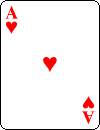

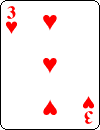
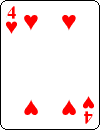
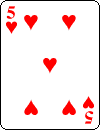
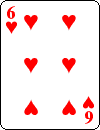
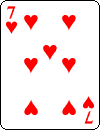
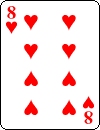
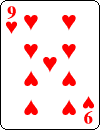
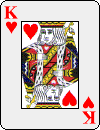
To get the cards in order 7, 4, 8, King, 6, 3, Ace, 9, 5, 2, Martin Gardner suggests picking up the cards along the "backslash" diagonals, from upper left to lower right, and carefully assembling into a single packet. The sneaky part is how the diagonals are slid together. Here's one way to do it:
- Pick up the 7 with the right hand and place it face-up in the left hand.
- Use the right hand to slide the 4 under the 8, putting this pair on top of the 7 in the left hand.
- Use the right hand to slide the 2 over the 5 and slide those two cards over the 9. Retain this packet in the right hand.
- Drop the 2, 5, 9 packet on top of the Ace, and slide these over the 3, 6 and King in turn, to form a seven-card packet in the right hand.
- Drop those seven cards as a unit on top of the three in the left hand.
- Turn the fully assembled ten-card packet over.
Alternatively,
- Pick up the 7 and drop it on top of the 4, then pick up both cards and drop them on top of the 8.
- Pick up those three cards and drop on top of the 2, then drop that pile on top of the 5, then drop that pile of top of the 9.
- Pick up that six-card packet and use it to gather up the last diagonal, as above, starting by dropping it on the Ace, then on the 3, 6, and finally on the King.
- Pick up up the resulting face up ten-card packet, and run off the top three cards into the other hand casually, thereby reversing their order. Drop the rest on top, and turn the packet face down.
Yet another possibility is to do this in reverse by picking up the four diagonals in question in the other order, starting with the longest one and working back to the lonesome 7, this time collecting the cards from lower right to upper left each time. The result is the face-up packet King, 6, 3, Ace, 9, 5, 2, 8, 4, 7. Now run off seven cards from the face, reversing their order, and tuck the remaining three cards behind those. Finally, turn the packet over.
Once the cards are in the order 7, 4, 8, King, 6, 3, Ace, 9, 5, 2, however you achieve this, you can then muddy the waters with various false shuffles, e.g., try the "quad run" false shuffle implicit in the first Card Colm (see Colm's Cards for details). This allows you to try out some patter along the lines of "From order, we get chaos," as you shuffle with no apparent purpose, followed a little later by, "Now let's see if we can get back to order," as you start to spell.
This charming curiosity is the basis of an effect called "The Pyramid Spell" which Martin published in an arcane publication put out in 1995 by Jeff Busby (Arcane, No. 14). Its ingenious construction is guaranteed to cast a real magical spell over the audience.
The original spelling principle can be found in Chapter 13 of Mathematical Carnival (Alfred A. Knopf, 1975), which is on the Scientific American books CD-ROM. There, Martin records that it was Mrs. Myron Milbouer, of Wilmington, Delaware, who noted the connection between the sequence 7, 4, 8, 0, 6, 3, 1, 9, 5, 2, and the number pyramid shown above in card form. How convenient it would be if there were an easy way to remember that sequence.
Wanted: Ordered card mnemonic/device for a wonderful spell (an).
Since 1988, Colm Mulcahy (colm@spelman.edu) has been in the department of mathematics at Spelman College, where a recent project of his was the creation and launching of the new BIO SIGMAA webpage. He can't help wondering if Martin Gardner's ninety second birthday was the shortest one he's had for a decade. For more on mathematical card tricks, see http://www5.spelman.edu/~colm/cards.html.




